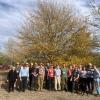Editor's Picks
Plant Focus
Nutrient resorption efficiency in Quercus ilex along a north-south gradient and its relation with climate
Poster presented at the XX International Botanical Conference, Madrid, Spain, July 21–27, 2024.
Authors:
Esteban Manrique1, Mohamed Alifriqui2, Christian Kindler3 and Francisco I. Pugnaire3
Affiliations:
1. Real Jardín Botánico, Spanish National Research Council CSIC, Claudio Moyano 1, 208014 Madrid, Spain
2. Biology Department, Cadi Ayyad University, BP 2390, 40001 Marrakech, Morocco
3. Estación Experimental de Zonas Áridas, Consejo Superior de Investigaciones Científicas (EEZA-CSIC), Carretera de Sacramento s/n, E-04120 La Cañada, Almería, Spain
Abstract:
Plants in nutrient-limited environments have developed strategies to maximize nutrient efficiency; for instance, by avoiding losses through nutrient resorption from senescent leaves. There seems to be no relationship between resorption efficiency and nutrient availability in soils and, therefore, other factors should control the process. Experimental manipulations have evidenced impacts of temperature and rainfall changes on nutrient resorption efficiency. We addressed the effects of these two climate factors on nutrient resorption efficiency in holm oak (Quercus ilex L.) forests, an evergreen species that dominates wide areas of the western Mediterranean Basin along with Q. rotundifolia Lam. Our objective is to analyze the importance of nutrient resorption efficiency (NRE) in Q. ilex along a latitudinal gradient from Bordeaux (France) in the north to Ain Asmama (Morocco) in the south, with several points in the Iberian Peninsula that differed in mean annual temperature and rainfall. Our results show that nutrient resorption efficiency (NRE) differed across sites and nutrients. NRE of N, P and K is linked to the nutrient pool in the green leaf and to N-S gradient, suggesting a water-controlled resorption mechanism.
















